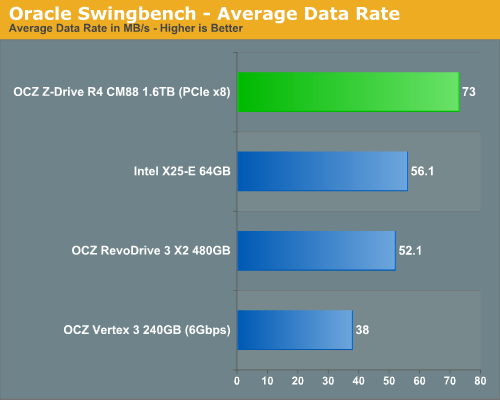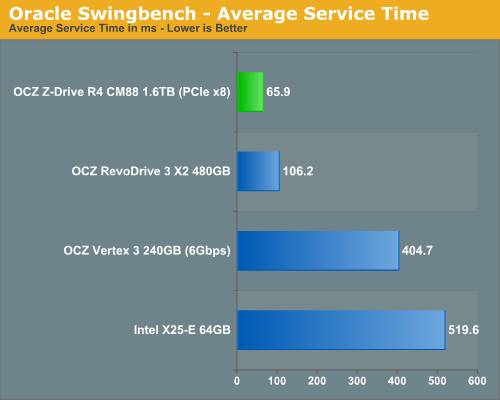OCZ Z-Drive R4 CM88 (1.6TB PCIe SSD) Review
by Anand Lal Shimpi on September 27, 2011 2:02 PM EST- Posted in
- Storage
- SSDs
- OCZ
- Z-Drive R4
- PCIe SSD
Enterprise Storage Bench - Oracle Swingbench
We've been toying with the idea of bringing enterprise performance tests to our SSD reviews for over a year now. We had expected to have more time to launch the suite but the Z-Drive R4 (and another enterprise SSD) were dropped on us unexpectedly so we had to rush things a bit. By no means is this the extent of our enterprise storage bench, but it's a start.
We begin with a popular benchmark from our server reviews: the Oracle Swingbench. This is a pretty typical OLTP workload that focuses on servers with a light to medium workload of 100 - 150 concurrent users. The database size is fairly small at 10GB, however the workload is absolutely brutal.
Swingbench consists of over 1.28 million read IOs and 3.55 million writes. The read/write GB ratio is nearly 1:1 (bigger reads than writes). Parallelism in this workload comes through aggregating IOs as 88% of the operations in this benchmark are 8KB or smaller. This test is actually something we use in our CPU reviews so its queue depth averages only 1.33. We will be following up with a version that features a much higher queue depth in the coming weeks.

Surprisingly enough the SF-2281 based drives don't actually do all that well here. A single Vertex 3 is only good for 38MB/s, while the old X25-E manages 56.1MB/s. The Z-Drive R4 is the fastest drive here but only by 30% margin.

The same results are reflected if we look at disk busy time. However as I mentioned before, this benchmark features a very low average queue depth. With only one IO running most of the time you're not going to see much of a difference between multi-controller and single-controller drives. Despite this fact there's still a 90%+ advantage the Z-Drive R4 enjoys over a single Vertex 3, implying that there are periods of extremely high queue depths that are simply being hidden in the average. In order to see how well the drive does in these periods of very heavy IO activity we need to look at another metric: average service time.

Average data rate and disk busy time tell us how much data is moved but they don't tell us how quickly each stacked IO completes. Average service time gives us this data. Here we see huge performance advantages for the SF-2281 drives, and the Z-Drive R4 is significantly faster than even the RevoDrive 3 X2.
Both metrics are important - one gives you an idea of average performance while the other illustrates how the drive performances under heavy load.










57 Comments
View All Comments
caliche - Wednesday, September 28, 2011 - link
I am sure he is referring to the previous versions of the z-drive, which is all you can use as an indicator.I am an enterprise customer. Dell R710s and two Z-Drive R2 M84 512GB models, one in each. I have had to RMA one of them once, and the other is on it's second RMA. They are super fast when they work, but three failures across two devices in less than a year is not production ready. We are using them in benchmarking servers running Red Hat Enterprise 5 for database stores, mostly read only to break other pieces of software talking to it. Very low writes.
But here is the thing. When they power on, one or more of the four RAID pieces is "gone". This is just the on board software on the SSD board itself, no OS, no I/O on it at all besides the power up RAID confidence check. Power on the server, works one day, next day the controller on the card says a piece is missing. That's not acceptable when you are trying to get things done.
In a perfect world, you have redundant and distributed everything with spare capacity and this is not a factor. But then you start looking at dealing with these failures and you start to ask yourself is your time better spent on screwing around with an RMA process and rebuilds or optimizing your environment?
ypsylon - Thursday, September 29, 2011 - link
Nobody in the right frame of mind using SSD in enterprise segment (not even interested in them as consumer drives, but that is not the issue here). SSDs are just as unreliable as normal HDDs with ridiculous price point. You can lose all of data much quicker than from normal HDD. RAID arrays built from standard HDDs are just as fast as 1 or 2 "uber" SSDs and cost fraction of a SSD setup (often even including cost of the RAID controller itself). Also nobody running large arrays in RAID0 (except maybe video processing). RAID0 is pretty much non-existent in serious storage applications. As a backup I much more prefer another HDD array than unreliable, impossible to test, super-duper expensive SSD.You can't tests NAND reliability. That is the biggest problem of SSDs in business class environment. Because of that SSD will whiter and die in the next 5-10 years. SSDs are not good enough for industry, if you can't hold on to big storage market then no matter how good something is, it will die. Huge, corporate customers are key to stay alive is storage market.
Zan Lynx - Thursday, September 29, 2011 - link
You are so, so wrong.Enterprises are loving SSDs and are buying piles of them.
SSDs are the best thing since sliced bread if you run a database server.
For one thing, the minimum latency of a PCIe SSD 4K read is almost 1,000 times less than a 4K read off a 15K SAS drive. The drive arrays don't even start to close the performance gap until well over 100 drives, and even then the drive array cannot match the minimum latency. It can only match the performance in parallel operations.
If you have a lot of operations that work at queue depth of 1, the SSD will win every time, no matter how large the disk array.
leonzio666 - Wednesday, November 2, 2011 - link
Bear in mind though, that enterprises (real heavy weights) probably preffer something like fusion-io io-drives which btw are the only ssd`s running in IBM driven blade servers. With speeds up to 3 Gb/s and over 320 k IOPS it`s not surprising they cost ca 20k $$ per unit :D So it`s not true that SSD`s in general are not good for the enterprise segment. Also, and this is hot - these ssd use SLC NAND...MCS7 - Thursday, September 29, 2011 - link
I remember Anand doing a VOODOO 2 card review (VIDEO) way way way back at the turn of the millenium! Oh boy..we are getting OLD....lol take care allGooger - Thursday, September 29, 2011 - link
Statistics for CPU usage would have been handy as some storage devices have greater demands for the CPU than others. Even between various HDD makes, CPU use varies.alpha754293 - Thursday, September 29, 2011 - link
Were you able to reproduce the SF-2xxxx BSOD issue with this? or is it limited to just the SF-2281?